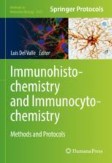Search
Search Results
-
Proximity Ligation Assay (PLA)
Proximity ligation assay (PLA), also referred to as Duolink® PLA technology, permits detection of protein–protein interactions in situ (<40 nm...
-
Proximity Ligation Assay to Detect the Proximity Between Host Proteins and Viral Proteins of HIV-1
The study of host-pathogen interaction often requires interrogating the protein-protein interactions and examining post-translational modifications...
-
In Situ Proximity Ligation Assay to Visualize Protein–Protein Interactions in Tumor Specimens
Protein–protein interactions (PPI) are the basis of various biological phenomena, such as intracellular signal transduction, gene transcription, and...
-
Proximity ligation assay to detect DUX4 protein in FSHD1 muscle: a pilot study
ObjectiveAberrant expression in skeletal muscle of DUX4, a double homeobox transcription factor, underlies pathogenesis in facioscapulohumeral...

-
Proximity Ligation in Situ Assay to Monitor Autophagy-Related Protein Interactions and Autophagy in Cancer Cells
Proximity ligation in situ assay (PLISA) is a powerful method to quantify endogen protein-protein interactions in cells and simultaneously identify...
-
Tau-proximity ligation assay reveals extensive previously undetected pathology prior to neurofibrillary tangles in preclinical Alzheimer’s disease
BackgroundMultimerization is a key process in prion-like disorders such as Alzheimer’s disease (AD), since it is a requirement for self-templating...

-
Study of GPCR Homo- and Heteroreceptor Complexes in Specific Neuronal Cell Populations Using the In Situ Proximity Ligation Assay
Membrane receptor, for example, G-protein-coupled receptors (GPCRs), operates via coordinated changes between the receptor expression, their...
-
PLK1 phosphorylates RhoGDI1 and promotes cancer cell migration and invasion
BackgroundRho guanine nucleotide dissociation inhibitor 1 (RhoGDI1) plays an important role in diverse cellular processes by regulating Rho guanosine...

-
TDP43 interacts with MLH1 and MSH6 proteins in a DNA damage-inducible manner
Amyotrophic lateral sclerosis (ALS) is a fatal neurodegenerative disease that affects the motor neuron. One aspect of the neuropathology involved in...

-
Proximity Ligation Assay
Many methods exist to study oncogenic signaling in lymphoma cells, each with certain strengths and weaknesses. The proximity ligation assay (PLA) is...
-
Discrepancy between distribution of alpha-synuclein oligomers and Lewy-related pathology in Parkinson’s disease
The pathological hallmarks of Parkinson’s disease (PD) are α-synuclein (αSYN)-positive inclusions referred to as Lewy bodies and Lewy neurites,...

-
Altered Distribution of SNARE Proteins in Primary Neurons Exposed to Different Alpha-Synuclein Proteoforms
Growing evidence indicates that the pathological alpha-synuclein (α-syn) aggregation in Parkinson’s disease (PD) and dementia with Lewy bodies (DLB)...

-
Proximity ligation assay reveals both pre- and postsynaptic localization of the APP-processing enzymes ADAM10 and BACE1 in rat and human adult brain
BackgroundSynaptic degeneration and accumulation of amyloid β-peptides (Aβ) are hallmarks of the Alzheimer diseased brain. Aβ is synaptotoxic and...

-
The DNA damage sensor ATM kinase interacts with the p53 mRNA and guides the DNA damage response pathway
BackgroundThe ATM kinase constitutes a master regulatory hub of DNA damage and activates the p53 response pathway by phosphorylating the MDM2...

-
Interaction of the Zika virus with the cytoplasmic dynein-1
Zika virus (ZIKV) infection is a major public health threat, making the study of its biology a matter of great importance. By analyzing the...

-
Amplified Luminescent Proximity Homogeneous Assay (Alpha)-Based Technique to Detect GPCR Oligomers in Human Postmortem Brain
Protein–protein interactions (PPI) play an important role in cellular functions and biological processes within the organism. G-protein-coupled...
-
Alpha-synuclein oligomers and small nerve fiber pathology in skin are potential biomarkers of Parkinson’s disease
The proximity ligation assay (PLA) is a specific and sensitive technique for the detection of αSyn oligomers (αSyn-PLA), early and toxic species...

-
Deubiquitylase YOD1 regulates CDK1 stability and drives triple-negative breast cancer tumorigenesis
BackgroundAccumulating evidence has demonstrated that aberrant expression of deubiquitinating enzymes is associated with the initiation and...

-
Identification of Dp140 and α1-syntrophin as novel molecular interactors of the neuronal CaV2.1 channel
The primary function of dystrophin is to form a link between the cytoskeleton and the extracellular matrix. In addition to this crucial structural...

-
Kinin B1 receptor and TLR4 interaction in inflammatory response
ObjectiveWe aimed to broaden our understanding of a potential interaction between B1R and TLR4, considering earlier studies suggesting that...

